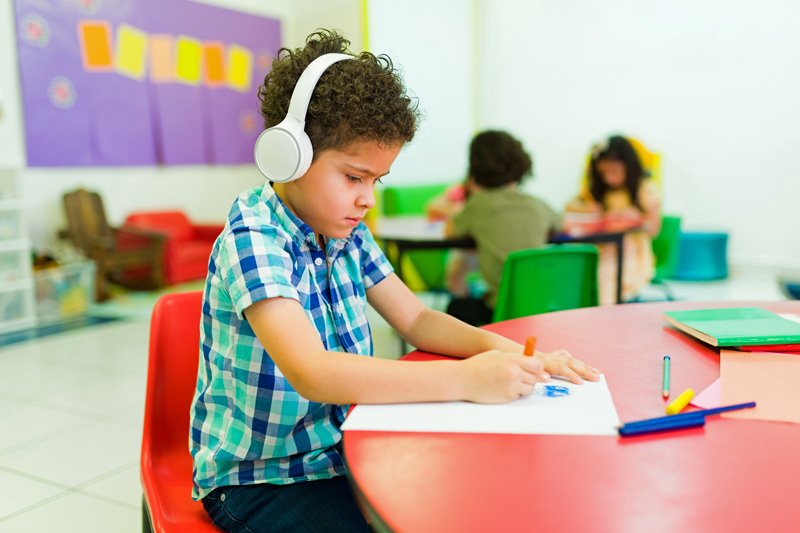Traditional classrooms were initially designed in the early 1900s, and some school districts have retained a similar structure. These settings typically involve large groups of children seated, remaining stationary, and primarily learning through listening and reading. Traditional classrooms require mature auditory processing and good visual motor and visual perceptual skills. For those who struggle with the sensory demands of a conventional classroom, focusing and learning becomes a source of frustration, anxiety, and unseen barriers to effective learning (Mullally, 2022).

Establishing Sensory-Friendly Classrooms
Creating a sensory-friendly classroom is essential for supporting students with sensory processing differences, such as autism spectrum disorder or attention disorders (Zulkanain & Mydin, 2019). Here are some effective strategies for establishing a sensory-friendly environment in the classroom:
- Room Layout: The classroom should have a variety of areas for both individual and group activities, including spaces that cater to different noise levels, ranging from louder to quieter environments (Nodding, 2017).
- Flexible Seating Options: Provide chairs, stools, and floor seating with a variety of textures, heights, and levels of firmness. Also, consider alternative seating options like wiggle cushions, stability balls, or fidget tools to accommodate different sensory preferences (Dickson, 2023).
- Visual Organization: Consider the walls to balance quiet space with visually engaging elements (Notbohm & Nomura, 2008). Provide a well-organized environment that could utilize visual schedules, charts, and cues to help students understand and anticipate daily routines. Visual support can include visual timetables, social stories, and visual transition cues.
- Lighting: Consider the lighting in the classroom. Natural light is preferable, but if not possible, use soft and adjustable lighting. Avoid flickering or harsh fluorescent lights (Nodding, 2017).
- Quiet Spaces: Designate quiet corners or sensory-friendly rooms where students can retreat when overwhelmed. Equip these spaces with soft lighting, comfortable seating, and sensory tools (Dickson, 2023).
- Noise Control: Implement noise reduction strategies such as using noise-canceling headphones, earplugs, or providing quiet spaces to minimize auditory distractions (Dickson, 2023).
- Sensory Breaks: Incorporate regular sensory breaks into the daily schedule, allowing students to engage in activities that help regulate their sensory systems, such as stretching, deep pressure activities, or sensory-friendly equipment (du Preez & Combrinck, 2022).
- Structured Routines: Establish predictable routines to provide a sense of security for students. Consistency and predictability can be comforting for those with sensory sensitivities (du Preez & Combrinck, 2022).
After evaluating the general classroom environment, including curriculum activities and hands-on materials that can be incorporated into the school day to assist diverse learners may be beneficial. Certain individual tools can be accessible to students in the classroom, possibly on a designated “sensory shelf,” or as part of classroom work (Noddings, 2017). These tools might encompass the following:
- Portable fidgets and squeeze balls in different textures and firmness levels suitable for hand-size use.
- Headphones with options for noise-canceling, silent, or music settings.
- Lap weights for sensory grounding.
- Fine-motor activities designed for accommodations and sensory diversity.
- Colored glasses to tone down visual input or block flickering from fluorescent lights.
- Stretch or resistance bands for movement breaks.
- Massage balls or foam rollers for tactile stimulation.
- Chewing tools like pencil toppers, pendants, or gum for oral sensory needs.
The Zones of Regulation
Another method to consider in implementing a sensory-friendly classroom is the Zones of Regulation curriculum, which targets the teaching of self-regulation skills by integrating executive functions, emotional regulation, and sensory processing. The Zones of Regulation curriculum is designed to assist children and adults in developing self-regulation skills. It classifies a child’s emotions and alertness levels into four distinct zones:
- Blue: Sad, bored, tired, sick.
- Green: Happy, focused, calm, proud.
- Yellow: Worried, frustrated, silly, excited.
- Red: Overjoyed, elated, panicked, angry, terrified.
The curriculum instructs children on recognizing their current zone and understanding the influence of their actions on others’ thoughts and feelings. Additionally, it provides strategies for managing emotions and sensory experiences.
Existing literature extensively covers interventions for individuals, focusing on enhancing executive function skills, emotional regulation, social-emotional learning skills, and sensory processing and their impact on developing self-regulation skills (Hubert et al., 2015; Sawyer et al., 2015; Wells et al., 2012). However, there is a noticeable gap in the published literature regarding systematic interventions for cultivating self-regulation skills across the entire class, encompassing students with and without disabilities (McQuaid, 2018).
Collaboration with occupational therapy practitioners to develop evidence-based practices, ensure the fidelity of the interventions, and carryover of sensory-friendly environments is essential (Sanger, 2021). Occupational therapy practitioners can significantly contribute to the educational team by providing direct instruction and collaborating with teachers.
Summary
Traditional classrooms, rooted in early 1900s designs, persist in certain school districts, posing challenges for effective learning and causing frustration and anxiety (Mullally, 2022). Educators who acknowledge these limitations are developing a growing emphasis on establishing sensory-friendly classrooms, notably to support students with sensory processing differences like autism spectrum disorder or attention disorders (Zulkanain & Mydin, 2019). Strategies for creating sensory-friendly environments encompass diverse elements such as room layout, flexible seating, visual organization, lighting, quiet spaces, noise control, sensory breaks, and structured routines (Nodding, 2017; Dickson, 2023; du Preez & Combrinck, 2022). Integrating individual tools like fidgets, headphones, and sensory-friendly materials addresses diverse learning needs (Noddings, 2017). The Zones of Regulation curriculum, categorizing emotions and alertness levels, provides a valuable method for teaching self-regulation skills (Sanger, 2021). By incorporating these strategies, educators can create a more inclusive and supportive sensory-friendly classroom environment, helping all students thrive academically and socially.
Suzanne Rappaport, OT, OTD, OTR, is an Assistant Professor at Regis College and Director of Occupational Therapy Services at The Guild for Human Services. For more information, email srappaport@guildhumanservices.org or suzanne.rappaport@regiscollege.edu.
References
Ben-Sasson, A., Carter, A. S., & Briggs-Gowan, M. J. (2009). Sensory Over-Responsivity in Elementary School: Prevalence and Social-Emotional Correlates. Journal of Abnormal Child Psychology, 37(5), 705–716.
Dickson, D. (2023, December 5) The neurodevelopmental classroom. Behavior, attention and learning skills in children, and strategies for success. Education resources. https://educationresourcesinc.com/courses/2018-08-16/therapies-in-the-school-conference-2-individual-sessions-the-neurodevelopmental-classroom-behavior-attention-and-learning-skills-in-children-and-strategies-for-success/
du Preez, H., & Combrinck, C.-M. (2022). The Sensory Classroom Teacher Questionnaire: A tool for assessing conducive classroom conditions for children with ADHD. African Journal of Psychological Assessment, 4(436). https://doi.org/10.4102/ajopa.v4i0.107
Hubert, B., Guimard, P., Florin, A., & Tracy, A. (2015). Indirect and direct relationships between self-regulation and academic achievement during the nursery/elementary school transition of French students. Early Education and Development, 26, 685–707. https://doi.org/10.1080/10409289.2015.1037624
McQuaid, E. (2018). Feasibility Study: Implementing the Zones of Regulation Curriculum at a Whole-Class Level…2018 AOTA Annual Conference & Expo, April 19-22, 2018, Salt Lake City, Utah. American Journal of Occupational Therapy, 72, 1. https://doi.org/10.5014/ajot.2018.72S1-PO1014
Mullally, V. (2022, August). In defense of the naughty child: Understanding sensory sensitivity [Video]. TED. https://www.ted.com/talks/val_mullally_in_defence_of_the_naughty_child_understanding_sensory_sensitivity
Noddings, A. (2017). Classroom Solutions for Sensory-Sensitive Students. Montessori Life: A Publication of the American Montessori Society, 29(2), 44–49.
Notbohm, E., & Nomura, V. (2008, January 1). The great indoors: classrooms that inspire learning: learning blossoms when the outdoors comes in as part of a sensory-friendly classroom. Children’s Voice Magazine, 17(1), 16.
Sanger, K. (2021). Zones of regulation® for preschool students: An intensive skills training intervention model [ProQuest Information & Learning]. In Dissertation Abstracts International Section A: Humanities and Social Sciences (Vol. 82, Issue 5–A).
Sawyer, A. C., Miller-Lewis, L. R., Searle, A. K., Sawyer, M. G., & Lynch, J. W. (2015). Is greater improvement in early self-regulation associated with fewer behavioral problems later in childhood? Developmental Psychology, 51, 1740–1755. https://doi.org/10.1037/a0039829
Wells, A. M., Chasnoff, I. J., Schmidt, C. A., Telford, E., & Schwartz, L. D. (2012). Neurocognitive habilitation therapy for children with fetal alcohol spectrum disorders: An adaptation of the Alert Program®. American Journal of Occupational Therapy, 66, 24–34. https://doi.org/10.5014/ajot.2012.002691
Zulkanain, M. I., & Mydin, M. A. O. (2019). Autism friendly classroom to stimulate learning setting. Analele Universitatii “Eftimie Murgu,”26(1), 245–252.







[…] practices — such as kinesthetic learning, assistive technology, tiered assignments and sensory-friendly tools — that meet their unique […]
[…] https://autismspectrumnews.org/supporting-sensory-diversity-building-inclusive-classrooms/ […]